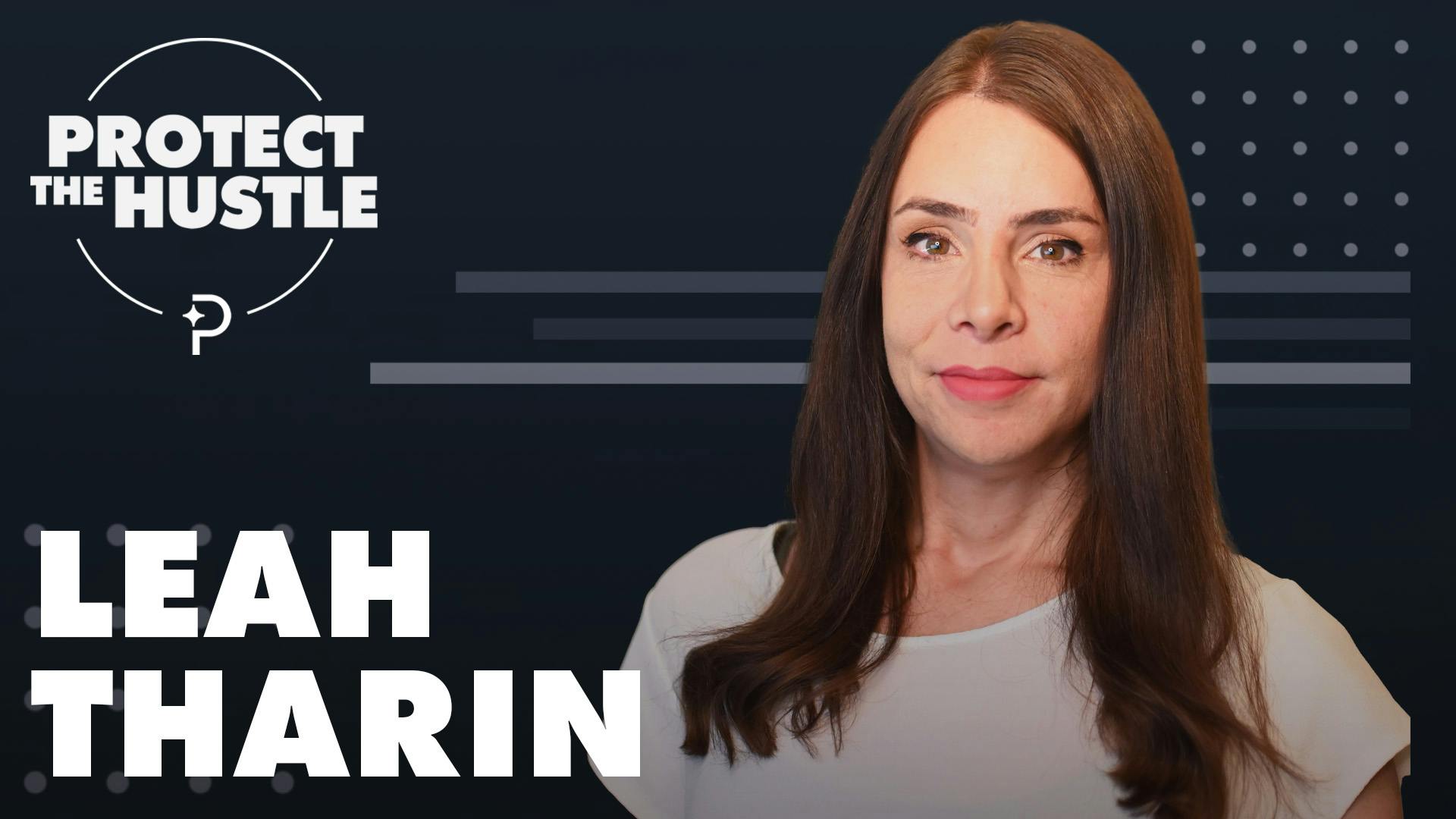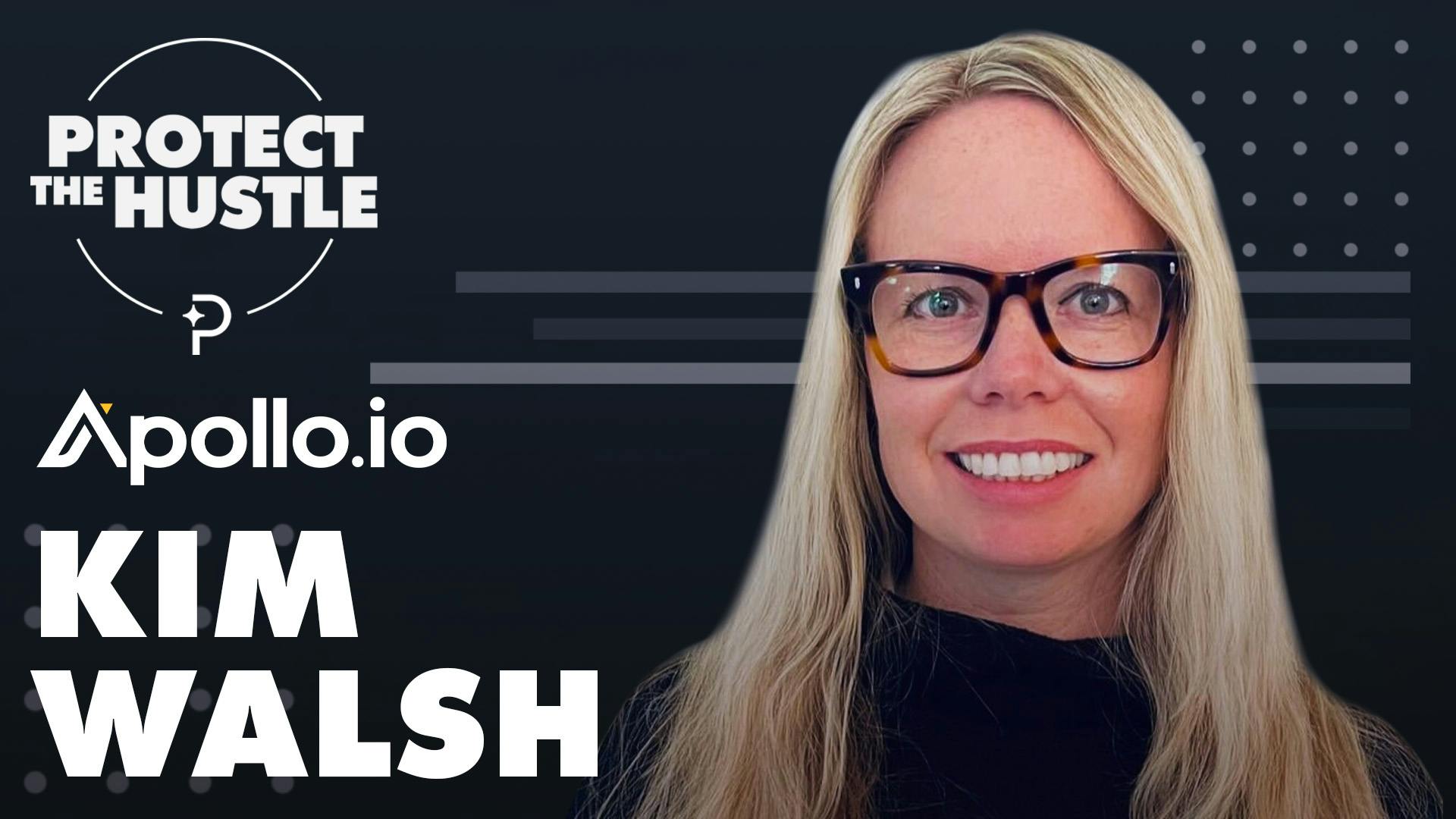
B-Side: Creating a pricing committee
Creating a pricing committee
It happened again.
A VP of Sales of one of our pricing customers yelled at someone on our team. I could easily write him off as some brash sales bro (and don’t worry, we addressed his behavior). Yet, I’ve seen this time and time again and your business suffers from the same problem.
So why is he acting this way?
It’s the same reason I see VPs of Product scared to ask about willingness to pay or CCOs scared to raise prices.
The reason? Pricing is emotional and causes politics to flourish, even in the best cultures.
Every single team influences pricing—from sales and marketing to product and finance. All this influence comes with lots of opinions. All those opinions lead to a lot of fear of getting blamed if something goes wrong.
In the face of that fear most of us either throw tantrums like a toddler or do absolutely nothing. In fact, this fear is the reason companies only optimize their pricing once every three years.
That analysis paralysis costs you a significant amount of revenue.
Here’s a breakdown of the growth in revenue per customer (ARPU, ARPA, ACV, etc) based on how often a company changes something about their monetization. Notice those companies optimizing pricing quarterly are seeing revenue per customer double every two years.
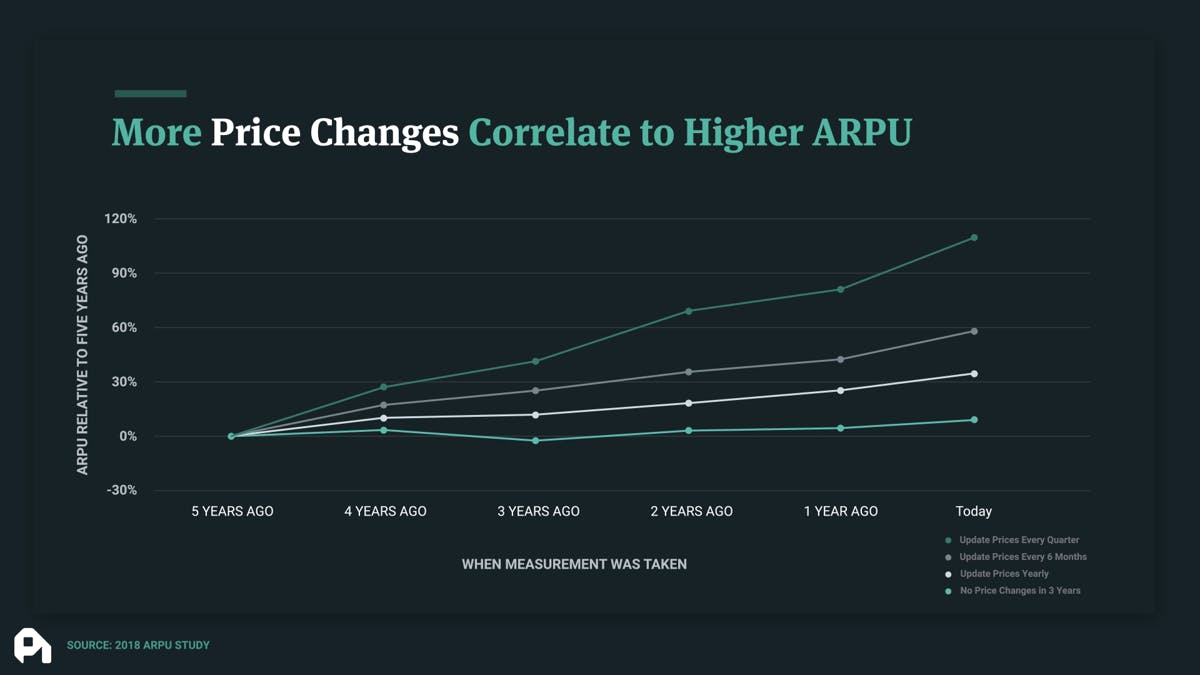
What do they have that you don’t?
It’s not some secret data; it’s not more intelligence; and it’s not a higher level of maturity.
It’s a pricing committee.
Yup—they have some bureaucracy inside their business, a modicum of process that allows them to cut through the noise and emotions. I know it sounds cumbersome, but I promise you it allows them to move much quicker and make a lot more revenue.
Let’s walk through the function, makeup, and tempo of a pricing committee, so you can implement one and get similar gains.
Start with why: Pricing committees and their aims
I’ve done this long enough to know some of you are reacting with, “Patrick raising your prices every three months is insane.” Thankfully, that’s not what I’m referring to when I speak about pricing changes. An optimization in your monetization is anything that influences the value of your product. These could be anything from internationalizing your pricing to re-adjusting your value metric.
To widen your brain a bit, here’s a non-exhaustive list of pricing changes you could be optimizing quarterly. Note that some of these take a lot more effort than others and some of these (like raising your prices) will occur once per year.
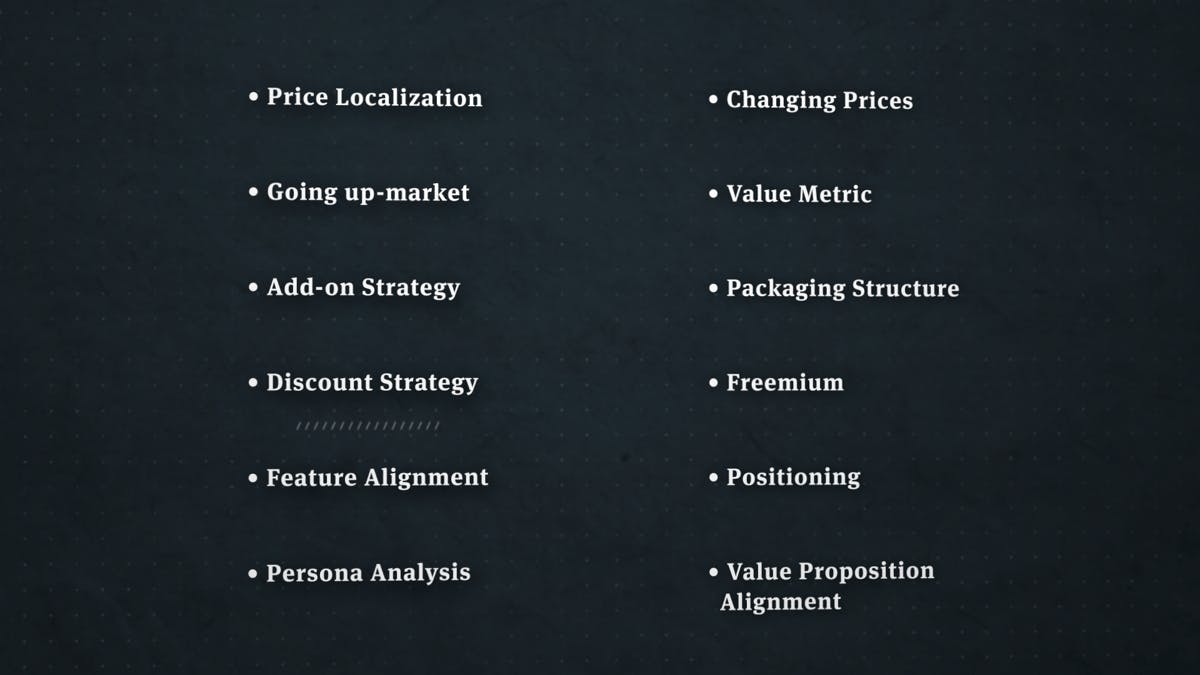
Pricing committees give you a central team to manage the data, people, and infrastructure around changes to your pricing. They allow you to move with confidence at a high tempo.
At their foundation, pricing committees have three main aims:
- Pricing version control
Since monetization has a lot of moving parts, your business needs a central repository for pricing history and knowledge. Adjustments you make will have unintended consequences. Some optimizations will take enormous effort to steer the ship. Other changes won’t work at $10M ARR, but will work at $50M ARR.
All of these changes need to be tracked and documented. You also need enough people on the committee to prevent all the knowledge from disappearing when one person leaves. - Structure feedback from all stakeholders; Minimize politics
One of the worst mistakes you can make in pricing is having one part of the organization doing all the research and coming up with a decision. You’ll then present that decision to sales and marketing who have to implement the changes and, more often than not, hit a brick wall of feedback that delays implementation sometimes indefinitely.
Pricing committees give clear lanes for all stakeholders to express their feedback. Depending on the gravity of the change, hearing this feedback allows the leaders of the pricing committee to address it with data or adjustments. - Streamlined implementation management and tracking progress
Deadlines and process are your friend when it comes to pricing changes. A good number of people will be needed for implementation, so centralizing the committee allows that enablement to happen quickly. You’ll also be able to make adjustments as bugs come up.
Remember, the ultimate goal of your pricing committee is to increase revenue per customer over time utilizing monetization. As you make changes numbers you anticipated going up will go up, but also numbers you didn’t anticipate moving will go down. Pricing committees allow you to move quickly to make adjustments while also minimizing the fallout of unintended consequences—all in the nature of pushing net revenue in the right direction.
Who’s on the pricing committee and who’s in charge?
In short, whoever has outsized influence on implementing or outsized feedback on a pricing change needs to be in the room regardless of seniority or organization. Putting the pricing committee together with this thesis can get tricky, because a large organization can have many individuals who fit this description.
We’ve found that following the Amazon concept of “two pizza teams” to be best. Basically the core pricing committee shouldn’t have more people than could be fed by two pizzas, which is a max of ten people. Keep in mind, this constraint doesn’t mean other individuals won’t be given a chance to provide feedback. We’ve just found anything over this number defeats most of the purposes of the pricing committee, greatly diminishing the ability to walk through the complexities and nuances of a pricing decision.
Your mileage will vary, but here’s a breakdown of who’s typically in the core pricing committee. Make note of the distinction between the core committee and the pricing influencer group made up of the next degree from the committee. These individuals will be those you’ll solicit asynchronous feedback from as changes come to light. Also, keep in mind that if you’re earlier stage, you may only have two people in the room total. You should still have a committee, but changes will be easier to make.
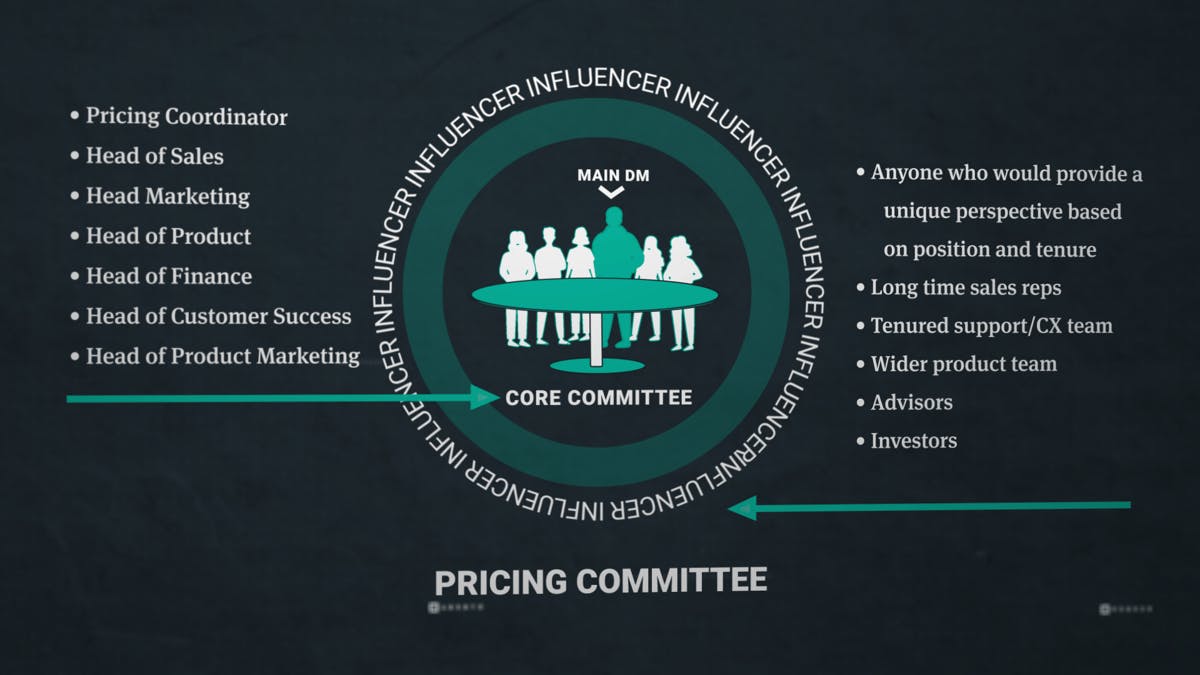
A main pricing coordinator is a must
Obviously, these are very expensive meetings, but this committee should be a braintrust providing feedback and synthesizing knowledge, rather than doing the day-to-day pricing research.
That research, the coordination of the committee, and keeping the trains moving needs to be managed by a pricing coordinator. In most organizations the coordinator is a product, product marketing, or marketing manager who takes on pricing as 20% of their time (at least). As your organization grows (and definitely by $100M ARR), you should have a full-time person dedicated to pricing.
We typically don’t recommend this person come from finance or corp dev, mainly because product, product marketing, and marketing should be much closer to the customer. Most pricing research is just a type of customer research, so these organizations tend to already have that function as opposed to most finance organizations being more focused on excel engineering.
Your pricing coordinator also needs the ability to speak truth to power. You’re going to have some sort of exec, intentionally or unintentionally, try to bully the pricing process. Finding someone who’s good at soft power, handling intense personalities, and garnering feedback from more introverted personalities is crucial here. If you don’t have this person, then with mentorship, it’s incredible executive training for a high potential team member.
One person in charge who’s involved throughout the process
Even though you have a good crop of folks involved on the pricing committee and pricing influencers group, you need one final decision maker. I know it sounds pedantic, but I’ve seen relatively well designed pricing committees fail because no one was deputized as being the person to make the final call at the deadline.
Your decision maker needs to be fully involved in the pricing committee though. One of the biggest mistakes we see is companies make this person simply a final approver, where they don’t attend or engage with the pricing committee. Most context and understanding of the research then gets lost and you end up facing the same thing you did without a committee: the final approver tanking a change because of their uninformed gut.
We see this often with larger organizations where the CEO still wants final approval. If this is the case, then they need to be involved and engaged from the beginning. As we’ll find out, it’s not that many meetings, but it does take mental bandwidth. If they can’t provide the time, then they need to delegate decision making to someone who is involved.
Normally if the CEO isn’t making the final call, whoever leads marketing or product makes the decisions. The assumption here is they’re the closest team to the customer, already conducting research independent of pricing. Sales or finance historically shouldn’t be the final decision makers, because sales is typically too shy to push for pricing changes within their incentives and finance doesn’t take enough time to validate the input into their models.
Your organization will vary. I’ve seen a good handful of organizations where sales or finance leading works. Yet, the important piece here is that you have someone with enough authority and trust. Pricing changes always have tradeoffs. Depending on the confidence of the organization if one of these tradeoffs is dramatic and unforeseen, the rest of the organization can run from any future pricing optimizations out of fear. Someone with authority and trust can provide enough cover to make adjustments and stay the course.
Ok, what do these people do? What’s the tempo of the committee?
Your pricing committee’s involvement will depend on the gravity of the change you’re looking to make. We’ll break down a couple of levels of changes, but normally committee members are involved with two to five meetings per quarter, influencers submit asynchronous feedback once per quarter, and the coordinator spends 20%-100% of their time on pricing.
Larger changes - one medium to large pricing change per quarter
The core tempo you should be focused on is implementing one medium to large change per quarter. Let’s imagine a company is looking to do so, we typically see companies running the following process:
- Week 1: Committee meets and confirms the pricing project for the quarter, sharing initial thoughts on the direction of the change (e.g., “I think in looking at our pricing metric, we should change it to seats instead of contacts."). The coordinator takes in all this feedback.
- Week 1-6: The coordinator goes off and utilizing the feedback designs a research sprint to collect and analyze data to determine a course of action (e.g., collects 1200 responses to a pricing survey about the new pricing metric).
- Week 7: The coordinator presents the findings and provides a recommendation to the committee. The committee almost always debates the recommendation and provides a bunch of questions, which the coordinator then needs to go chase down.
- Week 8: The committee meets again with the coordinator walking through their objections and answers to all of their questions. Sometimes this process repeats a couple of times depending on the gravity of the change. The coordinator then sends out the proposed change and research to the influencer group, fielding feedback.
- Week 9: The coordinator brings all the feedback and final recommendation with implementation plan for feedback and approval. A decision is made and the coordinator goes to work on implementing.
- Weeks 9-12: The coordinator implements the changes.
- Week 13: The coordinator reports to the committee any initial findings and adjustments, as well as a timeline for when to review the veracity of the pricing change.
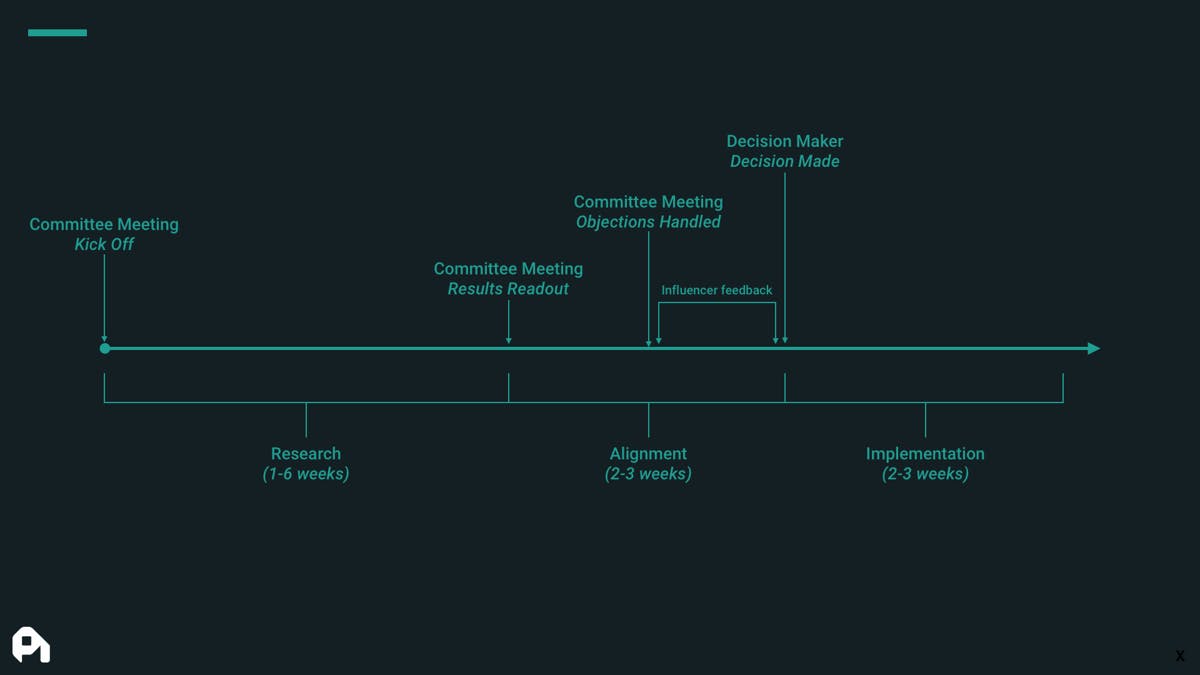
These are the major milestones and processes, but keep in mind that the coordinator will likely have a number of ad hoc discussions with different stakeholders. These could range from getting ahead on implementation through a discussion with engineering to working with an important stakeholder on their objections.
If you’re new to a pricing committee and changing up your pricing in general, I recommend using this timeline with something easier to implement. Optimizations like internationalizing your pricing are much easier than changes to your core pricing metric. The former is strictly changing up the price you’re charging in different locations while the latter is a fundamental, high impact shift. We’ve found that the easier the initial projects, the more momentum you get and momentum begets more momentum.
Smaller changes - ad hoc and likely a couple per quarter
As you dig into pricing more and more you’ll discover smaller changes that end up having a big impact. These changes normally don’t need the full weight of the pricing committee, but you should still follow a process to ensure the committee still has context. Examples of these types of changes include optimizations like redesigning the pricing page, experimenting with a new offer, deciding on if you should publish your pricing or not, etc. Typically a good rule here is anything that is less data driven and more values driven, or something that is low risk enough to move quickly on.
Here, the process is similar to the larger changes, but just compressed:
- Week 1: Pricing coordinator sends out a one pager on the proposed change. Depending on the gravity of the change the committee may meet for a session and provide feedback.
- Week 1-2: The main decision maker approves the launch.
- Week 2-3: The coordinator works on implementation, reporting asynchronously on the launch and any initial results.
Most of these changes are easy enough to track. Yet, the most important aspect that a lot of companies forget here is to make sure the communication is flowing transparently throughout the committee on these. A lot of these small changes end up being optimizations you’ll want to try the opposite of in two to three years as the company evolves. Ensuring the different versions of pricing are tracked and the knowledge saved, allows the organization to move quickly.
Tempo and momentum are the name of the game
When it comes to pricing, the larger the organization, the worse momentum tends to be when making optimizations. The opposite should be true since you know so much more about your customer than the first day of the business. But a lot of stakeholders and opinions create analysis paralysis or place pricing on the back burner.
Fortunately, some basic process management that you’ve likely already implemented in countless areas around the organization work with pricing, as well.
Just focus on the fundamentals of basic project management and make sure everyone who can influence or provide feedback on a pricing change is involved. Hopefully, you realized this isn’t rocket science. It just takes effort.
Do us a favor?
Part of the way we measure success is by seeing if our content is shareable. If you got value from this episode and write up, we'd appreciate a share on Twitter or LinkedIn.
00:00:00:02 - 00:00:27:15
Unknown
They are going to lose so much money. They're being idiots. I will admit. But it's not. It's not from a lack of intelligence or lack of effort. It's one of those things we see all the time because they're so disorganized. But we can help them with this It happened again. A VP of sales at one of our pricing customers decided to yell at someone on our team, and that is typically when I get involved.
00:00:28:00 - 00:00:49:21
Unknown
Now, it's easy to write this person off as just some brash sales bro, and we have definitely addressed his behavior. But I've seen this over and over again to know that this is just something that happens when people try to change their pricing. You may think that the biggest barrier to optimizing your monetization is going to be data or some sort of intelligence, but nope, the biggest barrier is internal politics.
00:00:50:02 - 00:01:12:22
Unknown
I didn't see that one coming, did you? Pricing is emotional and it's impacted by every single team at the company. So everyone's got an opinion and all those opinions lead to a lot of fear of getting blamed if something goes wrong. Now, in the face of that fear, most of us either throw tantrums like a toddler, like this individual, or do absolutely nothing with analysis, paralysis and all of that fear basically costs you money.
00:01:13:10 - 00:01:33:22
Unknown
Here's a breakdown of the growth in revenue per customer ARPU RPA, ACB. However, you're measuring it, we normalized it, don't worry. But here's a breakdown of the growth in revenue per customer base on how often a company changes something about the monetization. Notice that those companies that change pricing quarterly are seeing the biggest gains in revenue per customer, and most companies actually fall into the only changing pricing every three years bucket.
00:01:33:22 - 00:01:51:12
Unknown
So chances are if you are watching this, I'm talking to you, you are one of those companies and I'd like you to actually come clean comment below what bucket you fall into. Do you change your prices every quarter, every year? Or every three years? I'll pick one person from the comments and replies for a free pricing audit and I'll wait.
00:01:51:12 - 00:01:52:20
Unknown
I'll give you a second. Oh, wait.
00:01:55:02 - 00:02:09:07
Unknown
Okay. I'm assuming you want to get better. So what are these companies doing that are changing pricing so quickly that you aren't doing currently? They have this magical superpower and that magical superpower is something known as a pricing committee.
00:02:11:15 - 00:02:31:06
Unknown
Yeah, I know that sounds boring, bureaucratic, just terrible. But this modicum of process, this little amount of process allows them to cut through the noise and emotions to move quickly and make a lot more revenue. You want a lot more revenue? Yeah, I thought so. Cool. Let's walk through the function of a pricing committee, the make up of a pricing committee and the tempo of our pricing committee.
00:02:31:14 - 00:02:53:09
Unknown
So you can implement one and get those similar gains Okay. First up, I know I have been doing this long enough to know that some of you are going Patrick, raising your prices every three months is insane. Thankfully, that's not what I'm referring to when I speak about pricing changes and optimization and your monetization is anything, absolutely anything that influences the value of your product.
00:02:53:20 - 00:03:13:00
Unknown
These could be anything from international izing. Your pricing to readjusting your value metric is anything that influences that revenue per customer. So to widen your brain a bit, here's a non-exhaustive list of pricing changes that you could be doing every single quarter. Note that some of these take a lot more effort than others. And also some of these, like raising your prices probably will only take place once per year.
00:03:13:19 - 00:03:33:00
Unknown
Pricing committees give you a central team to manage the data, the people and the infrastructure around changes to your pricing. They allow you to move with confidence at a high tempo, and all pricing committees have three main aims. First, pricing version control monetization has a lot of moving parts. So your business is a central repository for pricing history and knowledge.
00:03:33:07 - 00:03:52:13
Unknown
Adjustments you make will have unintended consequences, and some optimizations will take an enormous effort to steer the ship. All of these changes need to be tracked and documented. You also need enough people in the committee to prevent all that knowledge disappearing when one person leaves. Next up, pricing committees need to structure feedback from all stakeholders and minimize politics.
00:03:52:23 - 00:04:12:19
Unknown
One of the worst mistakes you can make in pricing is one part of the or doing all of the research and coming up with a decision. And then boom, as soon as they present that to everyone else who has to implement it. Hitting a brick wall, a feedback that basically delays implementation indefinitely. Pricing committees give clear lanes for all stakeholders to express their feedback depending on the gravity of that change.
00:04:12:19 - 00:04:32:14
Unknown
Hearing this feedback allows those leaders of the pricing committee to address it with data or adjustments going forward. Last thing a pricing committee needs to streamline implementation and track progress Deadlines and process are your friend when it comes to pricing. A good number of people will be needed for the implementation, so centralizing the committee allows that enablement to happen quickly.
00:04:32:21 - 00:04:51:08
Unknown
You'll also be able to make adjustments as bugs come up. And remember, the ultimate goal is to increase that revenue per customer over time. So as you make changes, there's going to be unintended and intended consequences A pricing committee allows you to move quickly to make adjustments while also minimizing the fallout of those unintended consequences. Okay, so you're on board because you're still watching.
00:04:51:08 - 00:05:11:00
Unknown
So let's cover who the heck is on this committee and who in the world is in charge. In short, whoever has outsized influence on implementation or outside feedback on a pricing change needs to be in the room. Putting the pricing committee together with this thesis can get really tricky, because if you're watching this, you're probably part of a mid-sized, if not a large organization.
00:05:11:07 - 00:05:26:11
Unknown
So you have a lot of people who fit this description. We've actually found following the Amazon concept of two pizza teams to be best. And basically what this means that you're committed needs to be small enough that it can be said by two pizzas, which really is a max of ten people know kind of figuring out how to game the system here.
00:05:26:19 - 00:05:42:22
Unknown
Keep in mind, this constraint doesn't mean other individuals won't be given a chance to provide feedback. We just found that anything over this number defeats most of the purposes of the pricing committee and basically makes it really, really hard to make pricing changes. Your mileage is going to vary, but here's a breakdown of who's typically in the core pricing committee.
00:05:43:08 - 00:06:00:14
Unknown
Notice a couple of things. There are core committee members and then a pricing influencer group made up of the next degree from the committee. Those influencers will be able to provide asynchronous feedback, but just won't be in the room for the final decision. Also, if your earlier stage, there may only be two of you in the entire committee, and that's totally fine.
00:06:00:15 - 00:06:19:10
Unknown
You'll ironically move a lot quicker and ultimately make more pricing changes Obviously, these are going to be very expensive meetings, but keep in mind that this committee is there for feedback and knowledge rather than doing the actual day to day of pricing that research the coordination of the committee and keeping the trains running on time is done by someone known as a pricing coordinator.
00:06:19:18 - 00:06:38:13
Unknown
In most organizations, the coordinator is a product or marketing manager who takes up pricing is 20% of their time. As your organization grows and definitely by 100 million in annual revenue, you should have a full time person dedicated to pricing. Now, two big pieces on this pricing coordinator, they need to love customer research. Pricing research has just targeted customer research.
00:06:38:13 - 00:06:59:00
Unknown
And if you think this is just going to be SL engineering, looking at U. Corp Dev and finance, this is not going to be okay. Second, they have to be able to speak truth to power. You're going to have some sort of exact try to bully the pricing process. It happens all the time. You know, like it leave and finding someone who's good at soft power and garnering feedback from more introverted personalities is absolutely crucial here.
00:06:59:16 - 00:07:14:05
Unknown
Now, keep in mind, one of the benefits of this pricing coordinator position is it is a fantastic growth opportunity for someone who could be a future exec one because they'll be dealing with all the exacts in the company, but to because they're going to get a ton of mentorship from you and how to present and how to synthesize this information.
00:07:14:10 - 00:07:32:11
Unknown
Now, who's in charge, even though you have a good crop of folks involved in the pricing committee and there's a lot of pricing influencers, you need one final decision maker one, not, two not, oh, we're going to make this decision as a group. Not well, John really needs to have buy in because you're not going to get by it.
00:07:32:11 - 00:07:55:15
Unknown
You're not going to get a decision, you're not going to get the monies that come from pricing because nothing is going to happen. And I know it sounds pedantic and condescending, but I've just seen relatively well-designed pricing committees fail because no one was deputized as being the person to make the final call on a deadline. Your org is going to vary, but if you're between zero and $100 million a year, it's typically going to be the CEO, head of marketing or head of product above 100 million.
00:07:55:15 - 00:08:17:20
Unknown
You should have a very clear pricing leader, but it still may be the head of marketing or product making the final decision. Most importantly, make sure it's someone with trust in authority. Pricing changes always have tradeoffs. Something's going to go wrong. Something's going to go right. There's going to be unintended consequences, and someone with authority and trust can provide enough cover to make adjustments and stay the course through all of that institutional fear that will prop up your work.
00:08:19:06 - 00:08:37:04
Unknown
All right. Your pricing committees involvement will depend on the gravity of the change you're making. We'll break down a couple of levels of changes, but normally the committee really only needs two to five times per quarter. Influencers will typically submit feedback once per quarter, and the coordinator will spend 20 to 100% of their time on pricing. Let's first look at larger changes.
00:08:37:13 - 00:09:04:07
Unknown
Now, the core tempo, you should be focused on an organization is implementing one medium to large change per quarter, running the following process. In week one, the committee meets and confirms the project for the quarter, sharing all of their initial thoughts and feedback in weeks. One through six, the coordinator goes off and utilizing the feedback designed to research sprint and goes out and collects a bunch of data to determine a course of action and a recommendation in week seven, that coordinator will present the findings and provide a recommendation to the committee.
00:09:04:13 - 00:09:26:16
Unknown
The committee almost always debates the recommendation and provides a bunch of questions which the coordinator then needs to go out and chase down. And then in week eight, the committee meets again with the coordinator walking through the objections and answering all of the fun questions. Sometimes this process will repeat a couple of times depending on the gravity of the change, and then the coordinator will send out the proposed changes in research to the influence or group to get that final feedback.
00:09:26:21 - 00:09:52:00
Unknown
And once everything's decided which nine through 13 or basically spent implementing after final approval and reporting on those initial changes. Remember, this is a framework. Your mileage is going to vary, but the coordinator will have plenty of ad hoc discussions with different stakeholders for keeping the trains moving. Now, one thing to keep in mind is I highly recommend you start with something pretty easy to implement, things like internationalizing your pricing are much easier than changes to your core pricing metric.
00:09:52:09 - 00:10:14:09
Unknown
We found that the easier the initial project looks, the more momentum you get, and then that momentum begets more momentum Don't be afraid to use your committee for smaller changes as well. Things like redesigning your pricing page, experimenting with a new discount, or even deciding if you should publish your pricing page or not. Are all really, really good projects to work the pricing committee's muscles.
00:10:14:16 - 00:10:34:22
Unknown
These optimizations normally don't require data or low risk enough to move quickly, and also the process with these can remain pretty much the same, but it'll end up being compressed and maybe even asynchronously. Just make sure the communication is flowing transparently throughout the committee. A lot of these small changes end up being optimizations. You'll want to try the opposite of in two to three years as the company evolves.
00:10:35:04 - 00:11:00:12
Unknown
So ensuring the different versions of pricing are tracked and the knowledge saved allows the organization to move quickly Tempo, tempo. Tempo. Not quite my tempo. That is the name of the game when it comes to pricing. The larger the org typically the worse the tempo and momentum. Hopefully you realize none of this is rocket science. You just need the confidence to treat this like any other project management that you've done in your company.
00:11:00:20 - 00:11:16:13
Unknown
Just focus on those fundamentals. Make changes regularly, however small, and those pricing gains will continue to roll through. I'm sure you have a ton of opinions about this, so let me know. Did I inspire you to change your pricing more frequently? Are you already hitting up your team members to form a pricing committee? Do you already have a pricing committee?
00:11:16:13 - 00:11:29:08
Unknown
And I left something out that others would learn from. Leave a comment below. And diehard profile fans know, especially if those who have been to a webinar that I've run. I answer every single question and respond to every single comment. So I'll see in the comments

